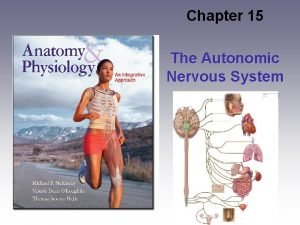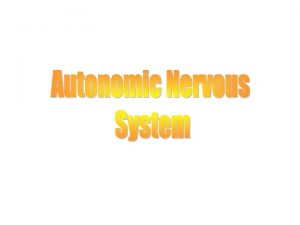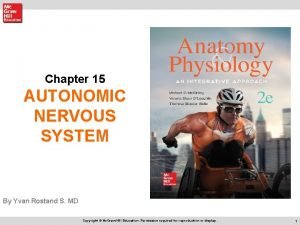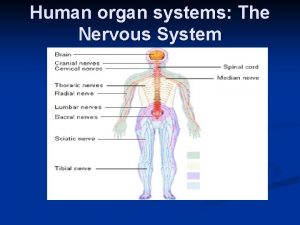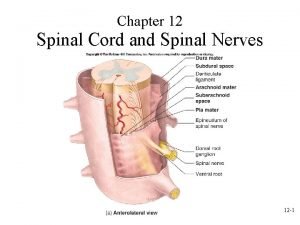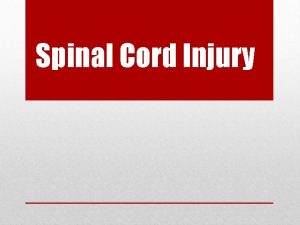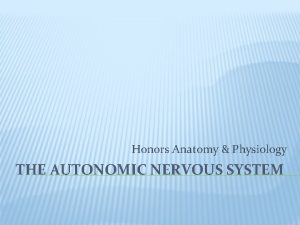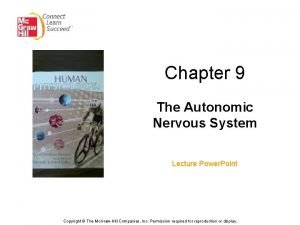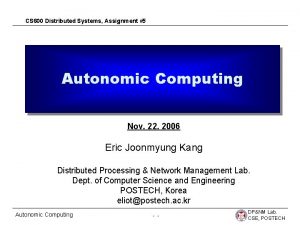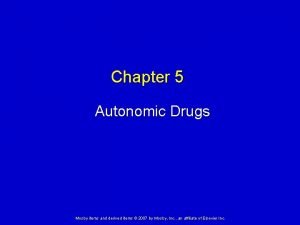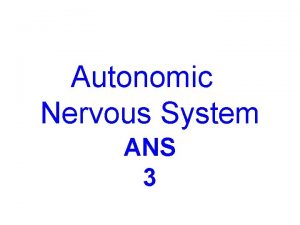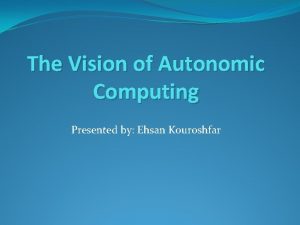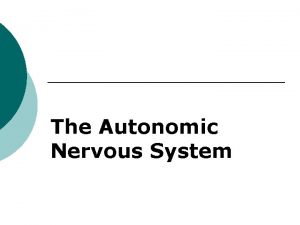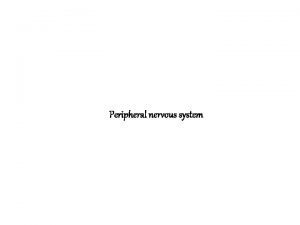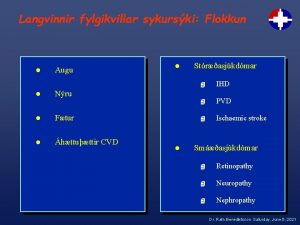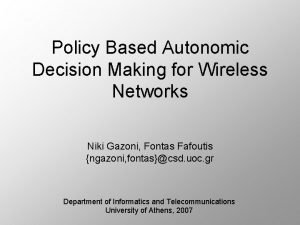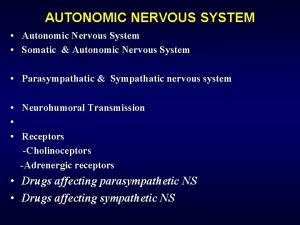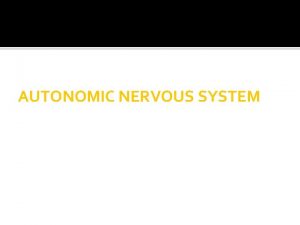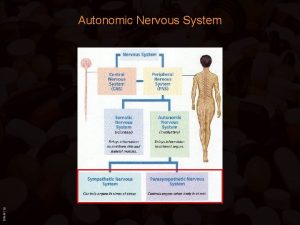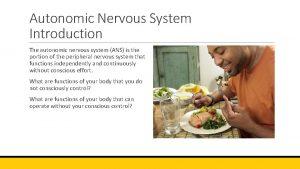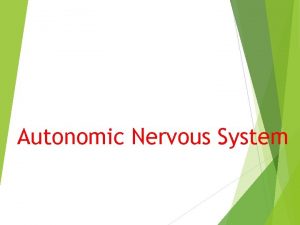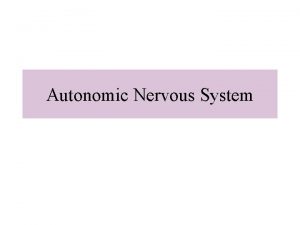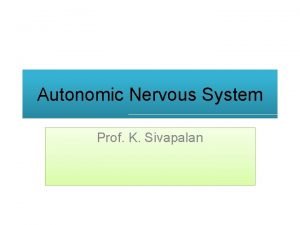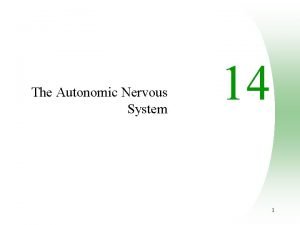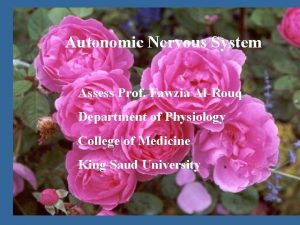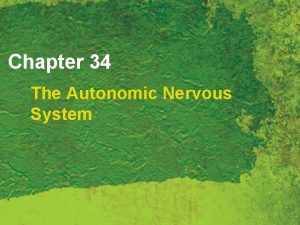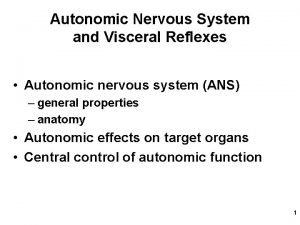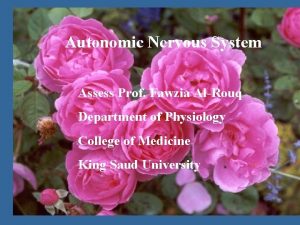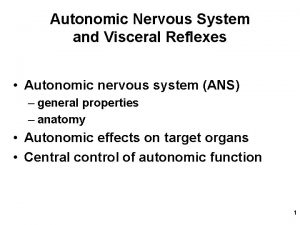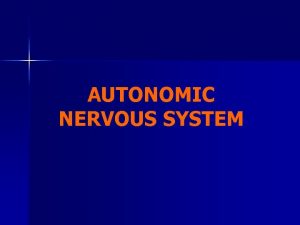PART 5 THE AUTONOMIC NERVOUS SYSTEM Unit 3




































- Slides: 36

PART 5 THE AUTONOMIC NERVOUS SYSTEM Unit 3 Communication and Control

Nervous System Divisions

A. INTRODUCTION

The Autonomic Nervous System Autonomic = visceral A subdivision of the PNS Sympathetic, parasympathetic and enteric divisions Regulates Glands Smooth muscle Cardiac muscle ANS activities are automatic (involuntary)

i. CLICKER Your client is prescribed a medication that targets the autonomic nervous system. Which effector will NOT be directly affected? a) b) c) d) Cardiac muscle Glands Smooth muscle Skeletal muscle

Review of SNS Voluntary and reflexive movements If somatic neurons stop = all communication with effector stops

The Autonomic Nervous System ANS components similar to those in SNS Sensory Receptor (intero, chemo, mechano) Autonomic Sensory Neuron Integrating Center Table 15. 1 Autonomic (preganglionic) Motor Neuron Effector Autonomic (postganglionic) Motor Neuron

i. CLICKER How many neurons are in an autonomic motor pathway ? a) b) c) d) 1 2 3 4

ANS Focuses on Efferent System Autonomic pathways = two motor neurons connecting SC effector Preganglionic Motor Neuron SC or brainstem (cell body) ganglion Myelinated Postganglionic Motor Neuron Ganglion (cell body) effector Unmyelinated NOTE: SNS has uninterrupted synapse

B. ANATOMY OF THE ANS Most organs have dual innervation

Sympathetic Nervous System

Sympathetic Nervous System Autonomic motor neurons Spinal cord Sympathetic preganglionic neuron (myelinated) Autonomic ganglion NE Sympathetic postganglionic neuron (unmyelinated) Effectors: glands, cardiac muscle, smooth muscle (e. g. , in urinary bladder)

Sympathetic Nervous System Exception to typical SANS system

Sympatheti c Chains

Sympathet ic Ganglia Right sympathetic trunk ganglion CELIAC GANGLION SUPERIOR MESENTERIC GANGLION INFERIOR MESENTERIC GANGLION Right sympathetic trunk ganglion Anterior view

Figure 15. 2 Structure of the Sympathetic ANS

i. CLICKER Which nerves carry sympathetic motor output? a) b) c) cranial nerves spinal nerves cranial nerves and spinal nerves

i. CLICKER Which neurotransmitter is released by sympathetic postganglionic neurons? a) b) c) d) acetylcholine epinephrine norepinephrine both b) and c)

Parasympathetic Nervous System

Parasympathetic Nervous System Autonomic ganglion Spinal cord Parasympathetic preganglionic neuron (myelinated) ACh Parasympathetic postganglionic neuron (unmyelinated) Effectors: glands, cardiac muscle, smooth muscle

Terminal ganglia

Figure 15. 3 Structure of the Parasympathe tic ANS

i. CLICKER Which nerves carry parasympathetic motor output? a) b) c) cranial nerves spinal nerves cranial nerves and spinal nerves

i. CLICKER Which neurotransmitter is released by parasympathetic postganglionic neurons? a) b) c) d) acetylcholine epinephrine norepinephrine both b) and c)

Enteric Nervous System Nerves & ganglia Wall of GI tract, pancreas, gallbladder GI tract needs to respond to environmental stimuli to fnc (like skin) ENS usually fnc independently from CNS

ANS Receptors

ANS Receptors

i. CLICKER Which receptor is found on effector cells of the parasympathetic nervous system? a) b) c) d) alpha beta muscarinic nicotinic

C. PHYSIOLOGY OF THE ANS

Autonomic Reflexes Interoreceptor Sensory Neuron Integrating Center Preganglionic. N euron Effector Postganglionic Neuron

Pupillary Light Reflex

Pupillary Light Reflex

The Effect of Higher Brain Centers on ANS Functions

D. FUNCTIONS OF THE ANS

Sympathetic Responses Four Es

Parasympathetic Responses SLUDD
 Somatic motor pathway
Somatic motor pathway Autonomic nervous system pathway
Autonomic nervous system pathway Autonomic nervous system consists of
Autonomic nervous system consists of Ans
Ans Ans
Ans Autonomic nervous system
Autonomic nervous system The autonomic nervous system controls
The autonomic nervous system controls Visceral nervous system
Visceral nervous system Autonomic nervous system
Autonomic nervous system Nervous system main division
Nervous system main division Neuronal pool
Neuronal pool Sensory input and motor output
Sensory input and motor output Nerve cell process
Nerve cell process Chemical synapses
Chemical synapses Cns diagram
Cns diagram Autonomic nerveous system
Autonomic nerveous system Basic unit of nervous system
Basic unit of nervous system Homeostasis positive feedback examples
Homeostasis positive feedback examples Subthalamus
Subthalamus Nervous system and digestive system
Nervous system and digestive system Endocrine system vs nervous system
Endocrine system vs nervous system Endocrine vs nervous system venn diagram
Endocrine vs nervous system venn diagram Endocrine system and nervous system
Endocrine system and nervous system Anal wink reflex
Anal wink reflex Visceral reflex arc in order
Visceral reflex arc in order Preganglionic and postganglionic parasympathetic neurons
Preganglionic and postganglionic parasympathetic neurons Autonomic network management
Autonomic network management An architectural blueprint for autonomic computing
An architectural blueprint for autonomic computing Autonomic drugs
Autonomic drugs Autonomic drugs
Autonomic drugs The vision of autonomic computing
The vision of autonomic computing Hypothalamus ans
Hypothalamus ans Autonomic state
Autonomic state Autonomic computing ibm
Autonomic computing ibm Diabetic autonomic neuropathy
Diabetic autonomic neuropathy Autonomic bladder
Autonomic bladder Autonomic decision making
Autonomic decision making





